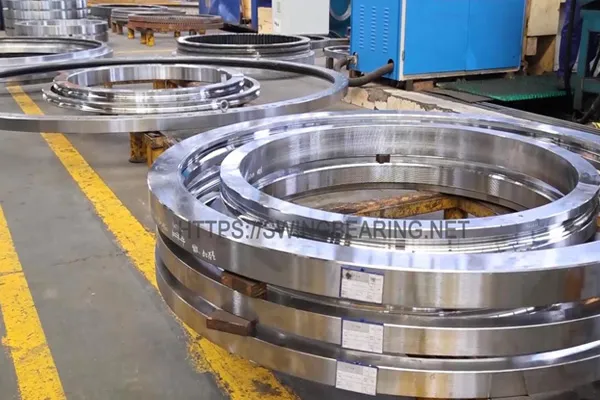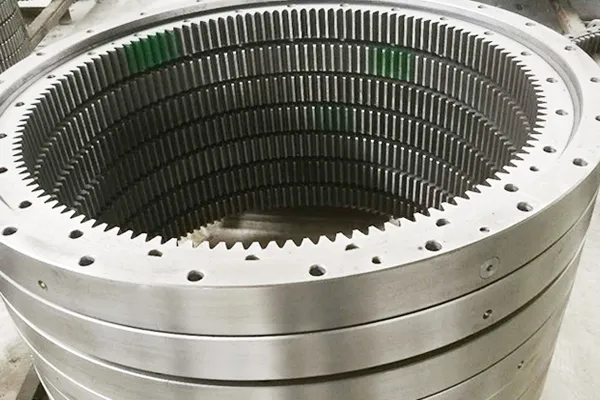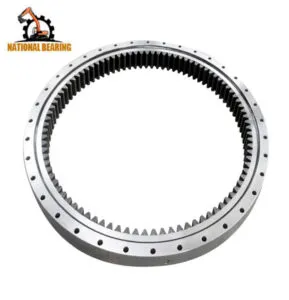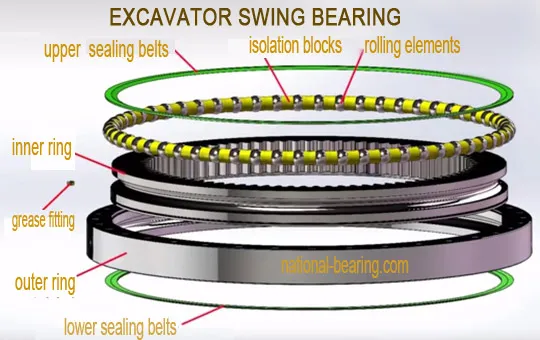
كشف النقاب عن القوة الخفية: تحديد موقع حلقة الدوران في الحفارة
حلقة الدوران (حلقة الدوران)، والمعروفة أيضًا باسم محمل التأرجح , هي مكون حاسم في الحفارة. وهي تقع في قاعدة الهيكل العلوي للحفارة وتسمح للهيكل العلوي بالدوران بالنسبة للهيكل السفلي. حلقة الدوران مسؤولة عن نقل وزن الهيكل العلوي وقوى الحفر إلى الهيكل السفلي. كما أنها تسمح للحفارة بالتأرجح من جانب إلى آخر.

حلقة دوران الحفارة
إن حلقة الدوران, a crucial component in an excavator, plays a pivotal role in enabling the machine’s upper structure to rotate smoothly upon its lower structure. Understanding its location is essential for maintenance and repair purposes.
عادةً ما يقع محمل التأرجح في قاعدة الهيكل العلوي للحفارة، حيث يتداخل مع الهيكل السفلي. وهو يتكون من حلقتين متحدة المركز، واحدة مثبتة بالهيكل العلوي والأخرى بالهيكل السفلي. يتم الفصل بين الحلقات بسلسلة من العناصر الدوارة، مثل المحامل الكروية أو البكرات، والتي تسهل الدوران.
لتحديد موقع محمل التأرجح، ابدأ بتحديد الهيكل العلوي والسفلي للحفارة. الهيكل العلوي هو الجزء الذي يضم الكابينة وذراع الرافعة والذراع، بينما يشتمل الهيكل السفلي على المسارات أو العجلات والهيكل السفلي.
بمجرد تحديد الهيكلين العلوي والسفلي، ابحث عن النقطة التي يتصلان فيها. وعادةً ما تكون هذه النقطة عبارة عن فتحة دائرية أو سداسية الشكل في وسط الهيكل العلوي. تقع حلقة الدوران داخل هذه الفتحة.
في بعض الحفارات، قد يكون المحمل المتأرجح محاطًا جزئيًا أو كليًا بمبيت واقي. يعمل هذا المبيت على الحفاظ على نظافة حلقة الدوران وتشحيمها، مما يطيل من عمرها الافتراضي. للوصول إلى حلقة الدوران، قد يكون من الضروري إزالة المبيت.
يمكن أن يختلف موقع حلقة الدوران قليلاً اعتماداً على طراز الحفارة المحددة والشركة المصنعة. ومع ذلك، فإنها توجد بشكل عام في قاعدة الهيكل العلوي، حيث توفر وصلة مستقرة وموثوقة بين الهيكلين العلوي والسفلي.
يعد فهم موقع حلقة الدوران أمرًا بالغ الأهمية لمهام الصيانة والإصلاح. يعد الفحص المنتظم والتشحيم المنتظم لحلقة الدوران أمرًا ضروريًا لضمان عملها بشكل صحيح ومنع التآكل أو التعطل المبكر. من خلال معرفة مكان وجود حلقة الدوران، يمكن للفنيين أداء هذه المهام بكفاءة، مما يزيد من أداء الحفارة وطول عمرها الافتراضي.
يقع محمل التأرجح، وهو مكون أساسي في الحفارة، في قاعدة الهيكل العلوي، حيث يتصل بالهيكل السفلي. يسمح هذا الموضع الاستراتيجي للهيكل العلوي بالدوران بسلاسة وكفاءة، مما يمكّن الحفارة من أداء مجموعة واسعة من المهام.
تتكون حلقة الدوران من مكونين رئيسيين: ترس داخلي وترس خارجي. يتم توصيل الترس الداخلي بالهيكل العلوي، بينما يتم تثبيت الترس الخارجي بالهيكل السفلي. عندما يقوم مشغِّل الحفارة بتنشيط محرك الدوران، يدور الترس الداخلي، مما يدفع الترس الخارجي ويتسبب في دوران الهيكل العلوي.
The slew ring plays a vital role in the excavator’s functionality. It provides a stable and reliable connection between the upper and lower structures, ensuring smooth and precise rotation. Without a properly functioning slew ring, the excavator would be unable to perform its intended tasks effectively.
إن موقع حلقة الدوران في قاعدة الهيكل العلوي ليس عمليًا فحسب، بل إنه مفيد أيضًا. يسمح هذا الموضع بسهولة الوصول إليها أثناء الصيانة والإصلاحات، مما يقلل من وقت التعطل ويضمن استمرار تشغيل الحفارة.
بالإضافة إلى وظيفتها الأساسية، تساهم حلقة الدوران أيضًا في ثبات الحفارة بشكل عام. من خلال توفير وصلة صلبة بين الهيكلين العلوي والسفلي، فإنها تساعد على توزيع وزن الحفارة بالتساوي، مما يمنعها من الانقلاب أثناء التشغيل.
علاوة على ذلك، يسمح موقع حلقة الدوران في قاعدة الهيكل العلوي بتركيب مكونات إضافية، مثل الخطوط الهيدروليكية والأسلاك الكهربائية. هذه المكونات ضرورية لتشغيل الحفارة ويتم توجيهها بشكل ملائم من خلال حلقة الدوران، مما يضمن حمايتها ووظائفها.
في الختام، تُعد حلقة الدوران مكونًا حاسمًا في الحفارة، وتقع في قاعدة الهيكل العلوي. يتيح وضعها الاستراتيجي الدوران السلس، ويوفر الثبات، ويسهل تركيب المكونات الأساسية. إن فهم وظيفة حلقة الدوران وأهميتها أمر بالغ الأهمية لضمان التشغيل الفعال والموثوق للحفارة.
The slewing ring is a vital component in an excavator, playing a pivotal role in enabling the upper structure to rotate smoothly upon the undercarriage. Understanding its location, structure, and function is essential for troubleshooting common issues related to this critical part. This detailed guide will help you identify, diagnose, and resolve problems associated with the slewing ring, ensuring your excavator operates efficiently.
The slewing ring is typically situated at the base of the excavator’s upper structure, where it interfaces with the lower frame. It comprises two concentric rings: one fixed to the upper structure and the other to the lower frame. Between these rings are rolling elements, such as ball bearings or rollers, that facilitate the rotation of the upper structure.
To access the slewing ring, it is necessary to remove the upper structure from the undercarriage. This involves several steps:
Once the upper structure is detached, the slewing ring becomes visible as a large, circular component located at the base of the upper frame.
The primary function of the slewing ring is to facilitate the rotation of the excavator’s upper structure relative to its undercarriage. This allows the operator to maneuver the boom, arm, and bucket with precision, enhancing the excavator’s versatility and efficiency. The slewing ring must withstand significant loads and stresses during operation, making its proper maintenance and functioning critical.
One of the most common issues with the slewing ring is excessive wear. This can result from various factors, including heavy usage, inadequate lubrication, and contamination. Symptoms of excessive wear include:
To diagnose excessive wear, perform the following checks:
If excessive wear is confirmed, take the following steps:
Proper lubrication is crucial for the smooth operation and longevity of the slewing ring. Inadequate or incorrect lubrication can lead to increased friction, overheating, and premature failure.
Signs of lubrication problems include:
To resolve lubrication issues:

محمل دوران الحفارة
Bearing failure in the slewing ring can have severe consequences, including total operational shutdown. This issue can be caused by various factors, including overloading, poor maintenance, and manufacturing defects.
Symptoms of bearing failure include:
If bearing failure is suspected:
Regular monitoring and maintenance are crucial for preventing issues with the slewing ring and ensuring its optimal performance.
Perform scheduled inspections to identify potential issues before they become severe:
Ensure that operators and maintenance personnel are adequately trained:
The slewing ring is a critical component of an excavator, enabling the upper structure to rotate smoothly upon the undercarriage. Understanding its location, structure, and function is essential for troubleshooting common issues and ensuring optimal performance. By regularly inspecting, maintaining, and addressing issues such as excessive wear, lubrication problems, and bearing failure, you can prolong the life of the slewing ring and enhance the overall efficiency and reliability of your excavator.
By following these detailed maintenance practices, you can ensure that your excavator’s hydraulic system remains in top condition, providing reliable performance and longevity. Regular monitoring, proper lubrication, and timely replacement of worn components are key to preventing common issues and maintaining the efficiency of the slewing ring.

هيكل حلقة الدوران
1. أين تقع حلقة الدوران في الحفارة؟
- تقع حلقة الدوران بين الهيكلين العلوي والسفلي للحفارة.
2. ما وظيفة حلقة الدوران في الحفارة؟
- تسمح حلقة الدوران للهيكل العلوي للحفارة بالدوران بالنسبة للهيكل السفلي.
3. ما هي الأنواع المختلفة لحلقات الدوران المستخدمة في الحفارات؟
- هناك نوعان رئيسيان من حلقات الدوران المستخدمة في الحفارات: حلقات الدوران ذات المحامل الكروية وحلقات الدوران ذات المحامل الأسطوانية.
تُعد حلقة الدوران، والمعروفة أيضًا باسم محمل التأرجح، مكونًا مهمًا يقع في قاعدة الهيكل العلوي للحفارة. وهو يوفر الدعم ويسمح للهيكل العلوي بالدوران بسلاسة على الهيكل السفلي، مما يمكّن الحفارة من إجراء عمليات الحفر والتنقيب بدقة وكفاءة.